
|
|
Für die deutsche Fassung bitte nach unten scrollen
|
|
Visit Us at the Salzburger Festspiele!
|
|
|
The preparations are in full swing: After months without any art fairs ART&ANTIQUE in the Residenzhof Salzburg will be worldwide one of the first events where collectors, art lovers and connoisseurs will meet again. We will be the only gallery for ancient art presenting millennium-old masterpieces with the best provenances. These include a Cypriot limestone head, of which no other than Napoleon was one of the previous owners, and a collection of rare bronze helmets dating to the Assyrian and Greek periods. I am delighted to present one of them as a highlight in this newsletter. We are looking forward to meeting you at ART&ANTIQUE from 8 to 16 August in the Salzburger Residenz, taking place in parallel to the Salzburger Festspiele. Entrance to the art fair is for free.
|
In July it is of course still possible, upon appointment, to visit our successful exhibition "the work that has to be done" in cooperation with the contemporary artist Philip Patkowitsch. We are looking forward walking with you through our showroom in Vienna.
|
|
|
|
|
|
Our Highlight of the Month:
|
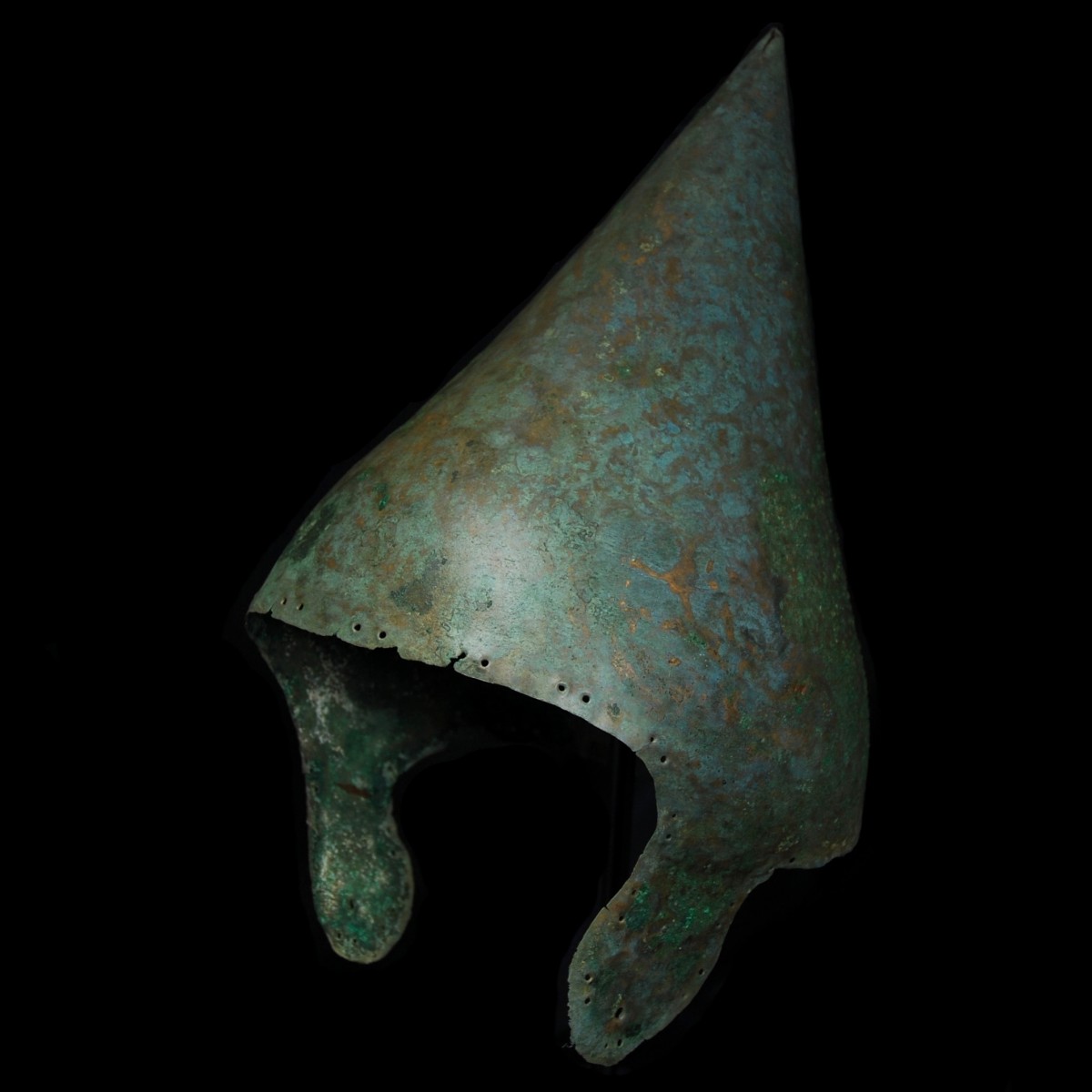
|
|
|
|
|
|
Assyrian Empire – 8th-7th century B.C.
|
Almost perfectly preserved helmet in conical form, which was made of one single bronze sheet including the cheek guards. The calotte is slightly curved outwards and ends at a tall point. The lower edge of the helmet is pierced along the face cut-out, the cheek guards and the rear part with holes arranged in pairs, which were used to attach a helmet lining flanged to the outside. The overlapping ends of the rolled-up bronze sheet are fixed with four rivets, three of which are still preserved. The helmet originates from the northern region of the Neo-Assyrian Empire and probably belonged to an Assyrian or Babylonian infantryman. Mounted.
|
Provenance: Belgian private collection Patje Aerssens (1907-1944), acquired 1959 in Tel Aviv, Israel. Accompanied by an original invoice.
Dimensions: 38.5 cm high
Price: 22 000 Euro
|
|
|
|
Selected Artworks of the Month:
|
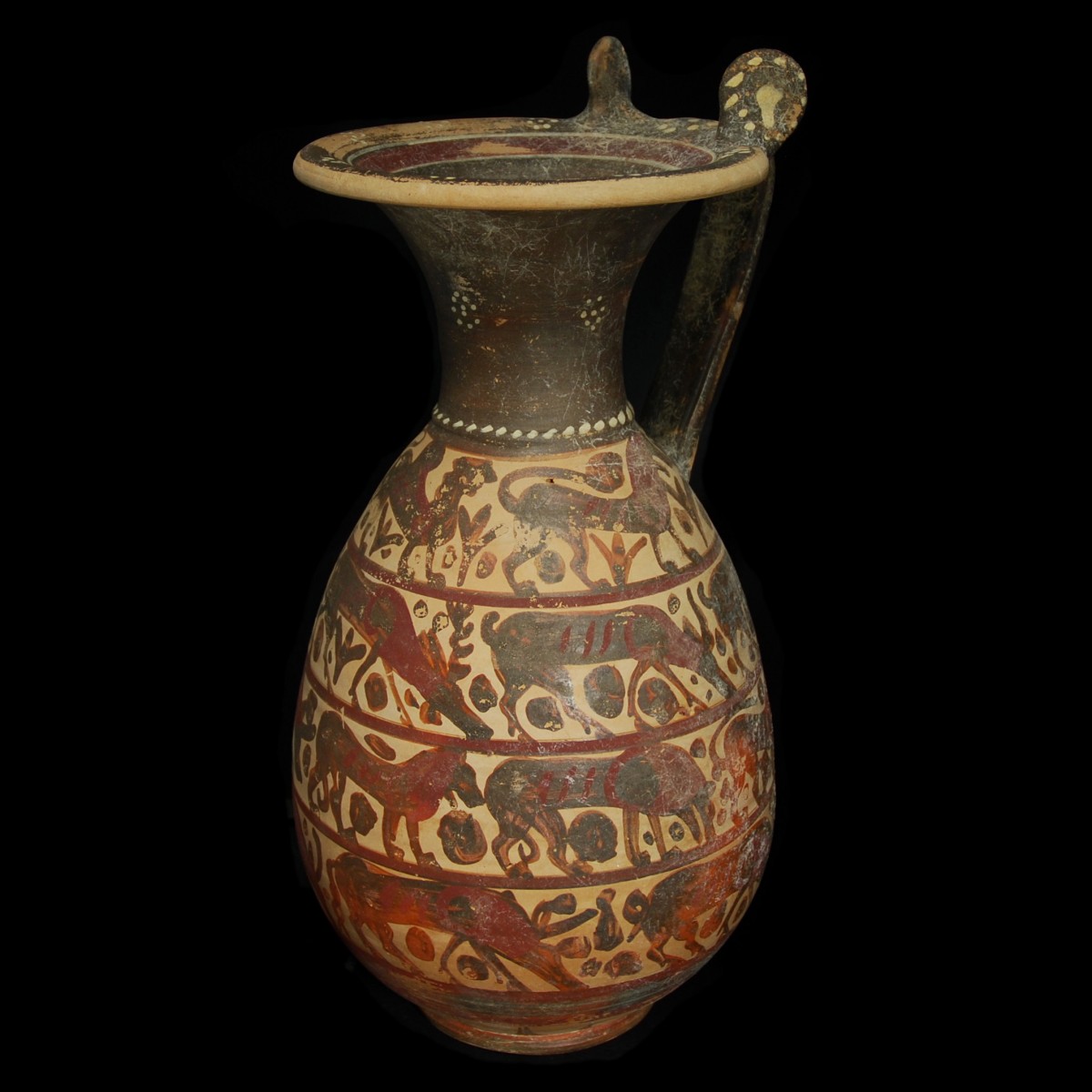
|
|
|
|
|
|
Etruria – 1st half of 6th century B.C.
|
Monumental olpe with black, red and white paint. The corpus with four painted animal friezes, depicting lions, ibexes, stags, a sphinx as well as a boar. Between them floral decoration and dots. The pitcher with a raised, broadening neck and a round estuary. On the rim two rotelles, between them the tripartite handle begins, setting off horizontally and then with a sharp bent finishing on the shoulder. On the neck, the rotelles, the estuary and next to the handle white rosettes. On the shoulder a profiling with encircling dotted decoration. The olpe can be attributed to the Pittore delle Teste di Lupo, who was active in Tarquinia during the first half of the 6th century B.C.
|
Provenance: Old Swiss private collection. Thence Galerie Puhze, Freiburg, Germany. From there acquired by the private collection Dr. Kaltwasser, Stuttgart, Germany in 2000.
Dimensions: 38 cm high
Price: 12 000 Euro
|
|
|
|
|
|
|
|
|
|
|
Roman Empire/Gallia Narbonensis – 1st-2nd century A.D.
|
Larger-than-life, marble left lower leg with foot. The foot with a sandal, which is tied in a cross over the ankle. A bulging ring forms the end. The leg with beautiful anatomical details and elaborated muscles. The lacing of the sandal and the foot posture suggest that it is the left leg of an overlife-size Diana statue. The provincial style indicates a Gallic workshop, probably in Gallia Narbonensis. Mounted.
|
Provenance: French private collection, at least from the 1st half of the 20th century. Accompanied by a French antiquities passport.
Dimensions: 55 cm high
Price: 14 000 Euro
|
|
|
|
|
|
|
|
|
|
|
Egypt – 26th dynasty, 664-525 B.C.
|
High-quality small bronze head of the goddess Hathor, which once crowned a bronze aegis. The goddess with very fine features, the eyes with inlays of white glass paste. She wears a tripartite wig, allowing the ears to be visible, as well as the pulled on vulture cap with hanging wings on the sides. On the back two claws are recognizable, each with a shen ring, a symbol of protection. She carries a kalathos with a wreath of uraei on the head. Mounted.
|
Provenance: French private collection Joseph Altounian (1890-1954), acquired prior to 1917 from Mihjos Dimitriou. The small head is mentioned in Joseph Altounian’s notes of 29 October 1917 as “Tête de bronze égide égyptien”. Since then in a family estate. Accompanied by a French antiquities passport.
Dimensions: 5 cm in diameter
Price: 5 200 Euro
|
|
|
|
|
|
|
|
|
Middle Europe – 13th century B.C.
|
A pair of decorated arm spirals made of round bronze wire. One end of the wire ends in a protruding hoop with a hook, the other ends in a large, finely curled spiral with eight coils and a central button. This so-called tutulus is worked out separately and fixed in the spiral with a cross brace. The spirals as well as the bronze wire up to the beginning of the hoop are decorated with slash patterns and parallel lines. Bronze jewelry like the present one was worn on the upper arm and also served as a defensive weapon.
|
Provenance: Belgian private collection 1970, thence on the art market with Dominique Thirion, Brussels, Belgium.
Dimensions: 15.3 cm high and 15.9 cm high respectively
Price: 2 800 Euro
|
|
|
|
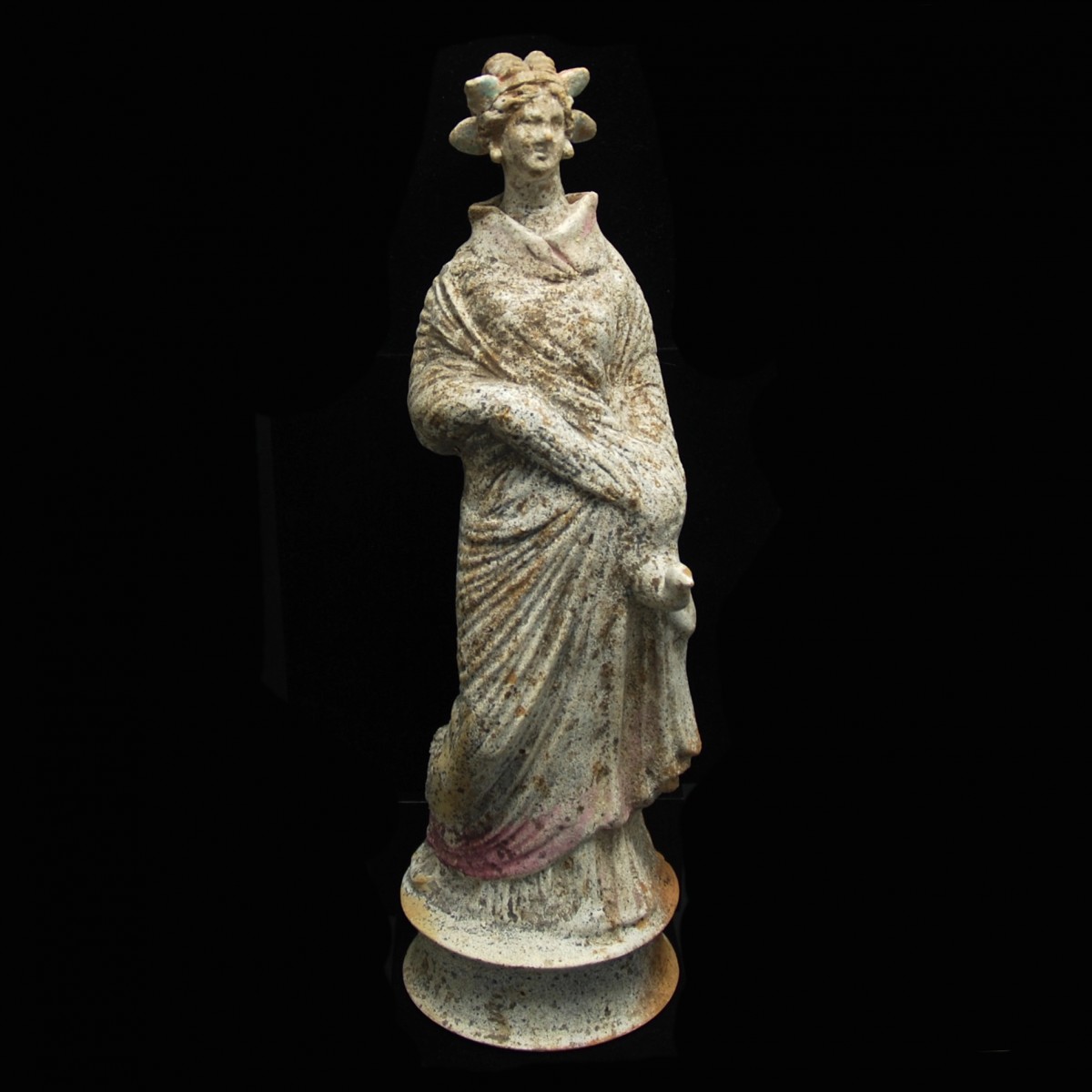
|
|
|
|
|
|
Greece/Canosa – 3rd century B.C.
|
Large terracotta statuette of a woman, standing on a round base. She wears a long chiton cascading to the ground. On top she is covered in a himation, which she wraps around her arms and from which long pleats fall along her left side. She holds in her left hand at waist height a duck, whose head and long neck look out under the himation. The lady stands with her weight on her left leg, the right free leg is slightly bent. Her hair is parted in the centre and pulled back. Two long bows cascading to her nape. She wears a leaf wreath on her head. With beautiful color remains.
|
Provenance: Old Belgian private collection, thence André Munter Archéologie, Brussels, Belgium. From there acquired on 1 October 2005 by another Belgian collection. Accompanied by an original certificate from André De Munter Archéologie, Brussels, Belgium. On the reverse of the certificate a sticker with a stamp of a court inspection dated 26 June 2009 with the signature of the law clerk F. Coene N.
Dimensions: 30 cm high
Price: 4 800 Euro
|
|
|
|

|
|
|
|
Egypt – Late Period, 664-332 B.C.
|
Very fine faience amulet of a lying lion. The animal has the left front paw stretched out and the right one lies over it. The tail curls in a circle around the left hip. The head with large, vigilant eyes, closed mouth and ears raised sideways. Right behind the head an eyelet for suspension.
|
Provenance: French private collection Pierre, Claude & Jeanine Verité, acquired between 1930 and 1980.
Dimensions: 6.6 cm long
Price: 2 200 Euro
|
|
|
|
|
|
|
|
|
Greece/Canosa – 3rd century B.C.
|
Elegantly formed oinochoe with a broad, semi-circular corpus, almost horizontal shoulder and slender neck tapering to a broad cloverleaf-shaped spout. The vase stands on a profiled, at the bottom flat foot. The handle starts at the shoulder, runs vertically to the top and clearly stands out over the spout, where it ends at the rim thereof. Still preserved is on the for Canosa typical white primer painting in rose, red and blue.
|
Provenance: Old Belgian private collection, thence with André Munter Archeologie, Brussels, Belgium. There acquired on 25 November 1999 by another Belgian private collection. Accompanied by an original certificate from André De Munter, Brussels, Belgium. On the reverse of the certificate a sticker with a stamp of a court inspection dated 26 June 2009 with the signature of the law clerk F. Coene N.
Dimensions: 23.8 cm high
Price: 1 200 Euro
|
|
|
|
|
|
|
|
|
Mesopotamia – 2nd millennium B.C.
|
Amulet of a turtle of wonderfully banded agate. The animal with a round shell and flat underside. The small, protruding head with two small perforations on top, once with inlays. The four extremities are elongated. To the left of the head a small hole for suspension. In Mesopotamia the turtle was not only a sought-after food but also attributed with healing power, the reason why it was worn as an amulet.
|
Provenance: American private collection, acquired in the 1980s. Last in a New York auction house.
Dimensions: 3.4 cm long
Price: 800 Euro
|
|
|
|
|
|
|
|
|
|
|
Roman Empire – 2nd-3rd century A.D.
|
Dolabra or pick-axe which belonged to the Roman legionary's equipment. The massive iron cast digging tool has a slightly set off round shaft hole for mounting on the wood handle. The dolabra has typically two edges, on one side a softly downwards tapering axe, on the other side a sharp hoe. It was used respectively for working with wood, as well as for earthworks and to tear down walls. Dolabras are referenced in ancient literature several times, and also depicted on the reliefs of the Trajan's Column. They were found in military camps, as well as on battle fields. This dolabra originates from a find in Rhineland.
|
Provenance: Collection Dr. Morkramer acquired in the 1960s to 1970s. Thence Antikenkabinett Gackstätter with the list number 4368. On 11 April 2012 acquired by Claus-Eberhard Schultze, Berlin, Germany. Since then in the collection. Accompanied by an original expertise of the Antikenkabinett Frankfurt signed by Bernd Gackstätter.
Dimensions: 53 cm high; 19.7 cm long (blade)
Price: 800 Euro
|
|
|
|
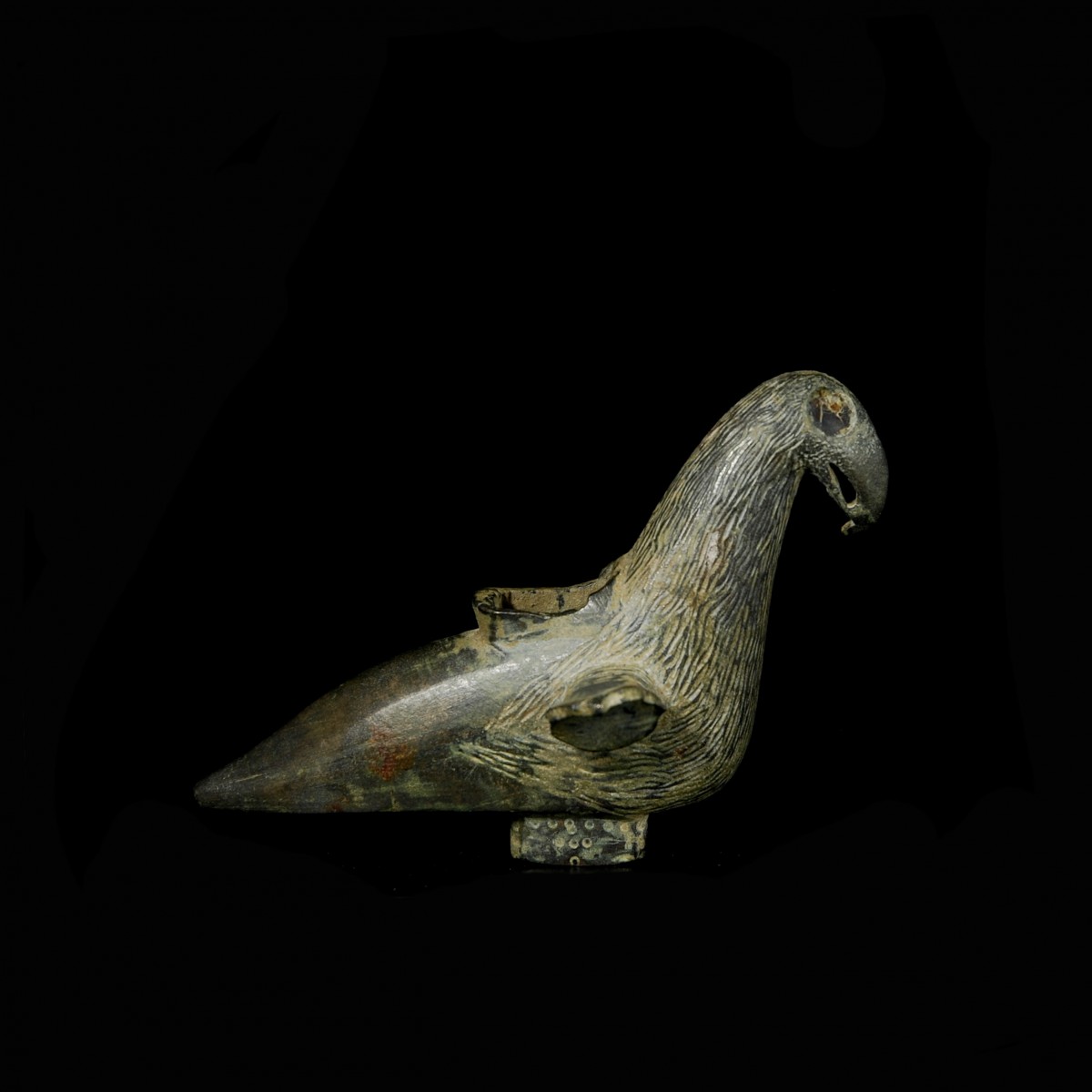
|
|
|
|
Byzantine Empire – 10th-12th century A.D.
|
Standard attachment in the shape of a stylized eagle. The framed opening at the bottom and on the back of the bird served for taking on the shaft. The animal itself is worked out in many details. The head with the bird of prey beak which is bent and tapering downwards. The beak itself is open on the side. Both round eyes are deeply notched, on one side an enamel inlay is still preserved. The plumage is thickly incised in cold work starting from the head. The tail is not decorated and tapering towards the end.
|
Provenance: Collection Dr. Deppert, acquired in the 1970s. Thence Galerie Antiken-Kabinett Gackstätter, Frankfurt, Germany. Accompanied by a certificate of Galerie Antiken-Kabinett Gackstätter, inventory number 4407.
Dimensions: 7.8 cm x 12.2 cm
Price: 900 Euro
|
|
|
|
|
|
|
|
|
Roman Empire – 2nd century A.D.
|
Solid cast bronze statuette of a chubby boy, seated with straddled legs on a mount. The hands in front of the chest possibly once held the reins. The boy is facing down to the animal. The rest of a quiver on the back suggests that this is Amor who possibly once rode on a dolphin, which was worked out separately. Beautiful, dynamic posture. Mounted.
|
Provenance: Professor Ehud Malberger, Haifa, Israel.
Dimensions: 6.5 cm high
Price: 900 Euro
|
|
|
|
|
|
Besuchen Sie uns auf den
Salzburger Festspielen!
|
Die Vorbereitungen laufen auf Hochtouren: Nach Monaten ohne Kunstmessen wird die ART&ANTIQUE im Residenzhof Salzburg eine der weltweit ersten Veranstaltungen sein, bei der Kunstsammler, Interessierte und Connaisseurs erstmals wieder aufeinandertreffen. Wir werden als einzige Galerie für Kunst der Antike jahrtausendealte Meisterwerke bester Provenienz präsentieren. Darunter einen zypriotischen Kalksteinkopf, zu dessen Vorbesitzern Napoleon zählte und eine Reihe von äußerst seltenen Bronze-Helmen aus assyrischer und griechischer Zeit. Einen davon, darf ich Ihnen als Highlight in diesem Newsletter bereits vorstellen. Wir freuen uns auf Sie – auf der ART&ANTIQUE von 8.-16. August in der Salzburger Residenz, die parallel zu den Salzburger Festspielen stattfindet. Der Entritt auf die Messe ist kostenlos.
|
Im Juli wird es natürlich weiterhin nach vorheriger Vereinbarung möglich sein, unsere erfolgreiche Ausstellung "the work that has to be done" in Kooperation mit dem zeitgenössischen Künstler Philip Patkowitsch zu besichtigen. Wir freuen uns, auf einen Rundgang mit Ihnen in unserem Showroom in Wien!
|
|
|
|
Unser Highlight des Monats:
|
|
Assyrisches Reich – 8.-7. Jahrhundert v. Chr.
|
Nahezu perfekt erhaltener Helm in Kegelform, der inklusive der Wangenklappen aus einem einzigen Bronzeblech gefertigt wurde. Die Kalotte ist leicht nach außen gewölbt und läuft in einer hohen Spitze aus. Die Unterseite des Helms ist entlang des Gesichtsausschnitts, des Wangenschutzes und des hinteren Teils mit paarweise angeordneten Löchern versehen, die der Befestigung eines nach außen umgebördelten Helmfutters dienten. Die überlappenden Enden des eingerollten Bronzeblechs sind mit vier Klammern fixiert, von denen noch drei erhalten sind. Der Helm stammt aus dem nördlichen Gebiet des neoassyrischen Reiches und gehörte wohl einem assyrischen oder babylonischen Infanteristen. Gesockelt.
|
Provenienz: Belgische Privatsammlung Patje Aerssens (1907-1994), erworben 1959 in Tel Aviv. Mit Kopie der Original-Rechnung.
Höhe: 38.5 cm
Preis: 22.000 Euro
|
|
|
|
Ausgewählte Kunstwerke des Monats:
|
|
|
|
Etrurien – 1. Hälfte 6. Jahrhundert v. Chr.
|
Monumentale Olpe mit schwarzer, roter und weißer Bemalung. Der Korpus mit vier gemalten Tierfriesen, die Löwen, Steinböcke, Hirsche, eine Sphinx sowie ein Wildschwein darstellen. Dazwischen florales Dekor und Punkte. Die Kanne mit hoch gezogenem, sich verbreitertendem Hals und runder Mündung. Am Rand zwei Rotellen, dazwischen setzt der dreigeteilte Henkel an, der sich horizontal absetzt und dann mit einem scharfen Knick zur Schulter verläuft. Am Hals, auf den Rotellen, an der Mündung und neben dem Henkel weiße Rosetten. Auf der Schulter eine Profilierung mit umlaufendem Punktdekor. Die Olpe kann dem Pittore delle Teste di Lupo zugeschrieben werden, der in der ersten Hälfte des 6. Jahrhunderts v. Chr. in Tarquinia aktiv war.
|
Provenienz: Alte Schweizer Privatsammlung. Danach Galerie Puhze, Freiburg. Dort erworben von der Privatsammlung Dr. Kaltwasser, Stuttgart im Jahr 2000.
Höhe: 38 cm
Preis: 18.000 Euro
|
|
|
|
|
Römisches Reich/Gallia Narbonensis – 1.-2. Jahrhundert n. Chr.
|
Überlebensgroßer, linker Unterschenkel mit Fuß aus Marmor. Der Fuß mit Sandale, die kreuzförmig über die Knöchel gebunden ist. Den Abschluss bildet ein wulstiger Ring. Das Bein mit schönen anatomischen Details und ausgearbeiteter Muskulatur. Die Schnürung der Sandale sowie die Fußhaltung lassen darauf schließen, dass es sich um das linke Bein einer Diana-Statue handelt. Der provinzielle Stil weist auf eine gallische Werkstatt hin, wohl in Gallia Narbonensis. Gesockelt.
|
Provenienz: Französische Privatsammlung zumindest aus der 1. Hälfte des 20. Jahrhunderts. Mit französischem Antikenpass.
Höhe: 55 cm
Preis: 14.000 Euro
|
|
|
|
|
Ägypten – 26. Dynastie, 664-525 v. Chr.
|
Hochwertiges Bronze-Köpfchen der Göttin Hathor, das einst eine brozene Ägis bekrönte. Die Göttin mit äußerst feinen Zügen, die Augen sind mit weißer Glaspaste eingelegt. Sie trägt eine dreiteilige Perücke, die die Ohren sichtbar lässt sowie die übergestülpte Geierhaube mit seitlich herunterhängenden Flügeln. Rückwärtig sind die zwei Klauen mit jeweils einem Schen-Ring, einem Schutzsymbol, zu erkennen. Am Haupt selbst trägt sie einen Kalathos mit Uräenkranz. Gesockelt.
|
Provenienz: Französische Privatsammlung Joseph Altounian (1890-1954), erworben vor 1917 von Mihjos Dimitriou. Das Köpfchen ist in Aufzeichnungen von Joseph Altounian vom 29. Oktober 1917 erwähnt als „Tête de bronze égide égyptien“. Seitdem in Familienbesitz. Mit französischem Antikenpass.
Höhe: 5 cm
Preis: 5.200 Euro
|
|
|
|
|
Mitteleuropa – 13. Jahrhundert v. Chr.
|
Ein Paar verzierte Armbergen aus rundem Bronzedraht. Das eine Ende des Drahtes läuft in einem abstehenden Reif mit Verschlusshaken aus, das andere in eine große, fein gedrehte Spirale mit acht Windungen und Mittelknopf. Dieser so genannte Tutulus ist separat gearbeitet und über eine Querverstrebung in der Spirale fixiert. Die Spiralen sowie der Bronzedraht bis zum Reifansatz sind mit Schrägstrichmuster sowie parallelen Linien verziert. Bronzeschmuck wie dieser wurde am Oberarm getragen und diente gleichzeitig als Schutzwaffe.
|
Provenienz: Belgische Privatsammlung 1970, danach im Kunsthandel bei Dominique Thirion, Brüssel.
Höhe: 15,3 cm bzw. 15,9 cm
Preis: 2.800 Euro
|
|
|
|
|
Griechenland/Canosa – 3. Jahrhundert v. Chr.
|
Große Terrakotta-Statuette einer Frau, die auf einer runden Basis steht. Sie trägt einen langen Chiton, der bis zum Boden fällt. Darüber ist sie in ein Himation gehüllt, das sie um die Arme gewickelt hat und von dem lange Falten auf ihrer linken Seite herabfallen. In ihrer linken Hand hält sie in Hüfthöhe eine Ente, deren Kopf und langer Hals unter dem Himation hervorschauen. Die Frau steht mit dem Gewicht auf ihrem linken Bein, das rechte Spielbein ist leicht abgewinkelt. Sie hat das Haar in der Mitte gescheitelt und hinten zusammengebunden. Zwei lange Schleifen fallen ihr in den Nacken. Am Kopf trägt sie einen Blätterkranz. Mit schönen polychromen Farbresten.
|
Provenienz: Alte belgische Privatsammlung, danach André Munter Archeologie, Brüssel. Dort erworben am 1. Oktober 2005 von einer anderen belgischen Sammlung. Mit Original-Zertifikat von André De Munter Archéologie, Brüssel. Auf der Rückseite des Zertifikats ein Aufkleber mit Stempel einer Gerichtsbeschau vom 26. Juni 2009 mit der Unterschrift des Gerichtsschreibers F. Coene N.
Höhe: 30 cm
Preis: 4.800 Euro
|
|
|
|
|
Ägypten – Spätzeit, 664-332 v. Chr.
|
Besonders feines Fayence-Amulett eines liegenden Löwen. Das Tier hat die linke Vorderpfote ausgestreckt und die rechte darüber gelegt. Der Schwanz ringelt sich kreisrund um die linke Hüfte. Der Kopf mit großen, wachen Augen, geschlossenem Maul und seitlich aufgestellten Ohren. Direkt hinter dem Kopf eine Öse zur Aufhängung.
|
Provenienz: Französische Privatsammlung Pierre, Claude & Jeanine Verité, erworben zwischen 1930 und 1980.
Länge: 6,6 cm
Preis: 2.200 Euro
|
|
|
|
|
Griechenland/Canosa – 3. Jahrhundert v. Chr.
|
Elegante geformte Oinochoe mit breitem, halbrunden Korpus, fast waagrechter Schulter und schlankem Hals, der oben zu einem breiten Kleeblattausguss ausläuft. Die Vase steht auf einem profilierten, unten flachen Standbein. Der Henkel setzt an der Schulter an, verläuft vertikal nach oben und überragt deutlich den Ausguss, ehe er am Rand desselben wieder ansetzt. Auf der für Keramik aus Canosa typischen weißen Grundierung ist noch reiche Malerei in Rosa, Rot und Blau erhalten.
|
Provenienz: Alte belgische Privatsammlung, danach André Munter Archeologie, Brüssel. Dort erworben am 25. November 1999 von einer anderen belgischen Sammlung. Mit Original-Zertifikat von André De Munter Archéologie, Brüssel. Auf der Rückseite des Zertifikats ein Aufkleber mit Stempel einer Gerichtsbeschau vom 26. Juni 2009 mit der Unterschrift des Gerichtsschreibers F. Coene N.
Höhe: 23,8 cm
Preis: 1.200 Euro
|
|
|
|
|
Mesopotamien – 2. Jahrtausend v. Chr.
|
Amulett einer Schildkröte aus wunderschön gebändertem Lagenachat. Das Tier mit rundem Panzer und flacher Unterseite. Der kleine, hervorstehende Kopf oben mit zwei kleinen Lochungen, in denen einst Einlagen waren. Die vier Extremitäten länglich ausgearbeitet. Links neben dem Kopf eine Längstbohrung zur Aufhängung. Die Schildkröte war in Mesopotamien nicht nur begehrtes Nahrungsmittel, ihr wurden auch heilende Kräfte zugesprochen, weshalb sie als Amulett getragen wurde.
|
Provenienz: Amerikanische Privatsammlung, erworben in den 1980er Jahren. Zuletzt in einem New Yorker Auktionshaus.
Höhe: 3,4 cm lang
Preis: 800 Euro
|
|
|
|
|
Römisches Reich – 2.-3. Jahrhundert n. Chr.
|
Dolabra oder Pionieraxt, die zur römischen Legionärsausrüstung zählte. Das massiv gegossene eiserne Schanzwerkzeug hat leicht versetzt ein rundes Schaftloch zur Befestigung des hölzernen Griffes. Die Dolabra weist typisch zwei Schneiden auf, auf der einen Seite eine sanft abschwingende Axt, die spitz zuläuft, auf der anderen Seite eine scharfe Hacke. Sie wurde dementsprechend sowohl zur Holzbearbeitung als auch für Erdarbeiten und zum Einreißen von Mauern verwendet. Dolabras sind in der antiken Literatur mehrfach erwähnt und etwa auf den Reliefs der Trajanssäule abgebildet. Gefunden wurden sie in Militärlagern genauso wie auf Schlachtfeldern. Diese Dolabra stammt aus einem Fund im Rheinland.
|
Provenienz: Sammlung Dr. Morkramer erworben in den 1960er bis 1970er Jahren. Danach Antikenkabinett Gackstätter mit der Listennummer 4368. Am 11. April 2012 erworben von Claus-Eberhard Schultze, Berlin. Seitdem in Sammlungsbesitz. Mit Original-Expertise des Antikenkabinetts Frankfurt unterschrieben von Bernd Gackstätter.
Höhe: 53 cm
|
Länge Klinge: 19,7 cm
Preis: 800 Euro
|
|
|
|
|
Byzantinisches Reich – 10.-12. Jahrhundert n. Chr.
|
|
Standartenaufsatz in Form eines stilisierten Adlers. Die gerahmten Öffnungen am Boden und am Rücken des Vogels dienten zur Aufnahme des Schaftes. Das Tier selbst ist sehr detailreich gearbeitet. Der Kopf mit dem gekrümmten nach unten spitz auslaufenden Raubvogelschnabel. Der Schnabel selbst ist seitlich geöffnet. Die beiden runden Augen sind tief eingekehlt, auf einer Seite ist die Emaille-Einlage noch erhalten. Das Gefieder ist vom Kopf weg dicht in Kaltarbeit geritzt. Der Schwanz ist undekoriert und verjüngt sich zum Ende hin.
|
Dimensionen: 7,8 cm x 12,2 cm
Preis: 900 Euro
|
|
|
|
|
Römisches Reich – 2. Jahrhundert n. Chr.
|
Massiv gegossene Bronze-Statuette eines pausbäckigen Knaben, der mit gespreizten Beinen auf einem Reittier saß. Die Hände vor der Brust hielten wohl einst die Zügel. Der Blick des Kindes ist nach unten zum Tier gewandt. Die Reste eines Köchers auf der Rückseite lassen annehmen, dass wir es hier mit Amor zu tun haben, der vielleicht auf einem separat gearbeiteten Delphin ritt. Schöne dynamische Körperhaltung. Gesockelt.
|
Höhe: 6,5 cm
Preis: 900 Euro
|
|
|
|
|
|
|
|
|
|
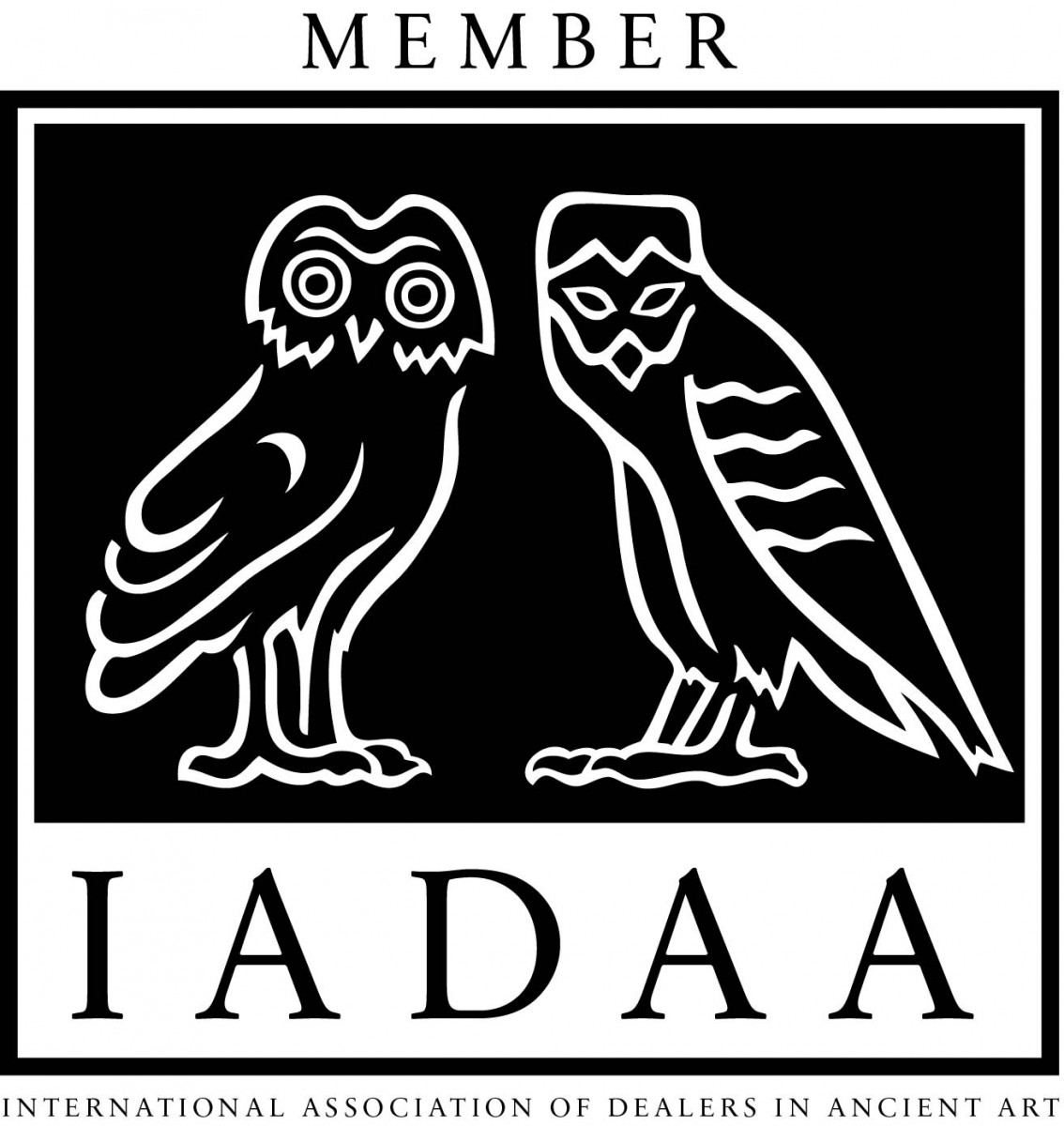
|
|
|
|